Related Research Articles
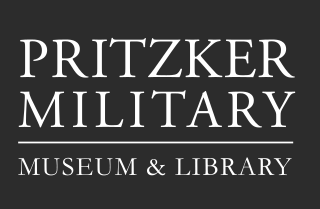
The Pritzker Military Museum & Library is a non-profit museum and a research library for the study of military history on Michigan Avenue in Chicago, Illinois. The institution was founded in 2003, and its specialist collections include material relating to Winston Churchill and war-related sheet music.

William Arthur Foley Jr. was an American painter, sketch artist, muralist, and author whose work focused on his personal experience during World War II. At the age of eighteen, Foley fought on the front lines of the Battle of The Bulge in the 94th Infantry Division as a rifleman. As he fought he began sketching his experiences daily. These sketches later transformed into paintings after the war and would later form the basis for his career and reputation as an artist and author. He died in April 2020 at the age of 93.

We are all Americans (allegiance) is a song written during World War I with music composed by Carrie Jacobs-Bond and lyrics written by Fanny Hodges Newman. It is found in the Library of Congress record of notable music.

God Be With Our Boys Tonight is a World War I era song written by Wilfrid Sanderson and Fred G. Bowles in 1918. It reached number three on the US top 100 songs of June 1918.
Chorale is a modern dance work choreographed by Martha Graham to music by César Franck. The piece premiered on April 18, 1926 at New York's 48 Street Theater in the first independent concert presented by Graham. Members of the newly formed Martha Graham Concert Group, Thelma Biracree, Evelyn Sabin and Betty Macdonald, also appeared in the piece. A critic for The Democrat-Chronicle reported the dance was "subtle" with a "dark, emotional mood."
Punch and the Judy is a comic ballet about marital discord choreographed by Martha Graham to music by Robert McBride. Arch Lauterer designed the set, Charlotte Trowbridge, the costumes. Edward Gordon Craig provided text for the narrated portions. The piece premiered on August 10, 1941, at the Bennington College Theatre in Bennington, Vermont.
The Call of the U.S.A. is a World War I era song released in 1918. Lyrics and music were written by John J. Donahue. The song was published in Lawrence, Massachusetts by Donahue. On the cover of the sheet music, there is an officer riding on horseback, alongside marching soldiers. The sheet music can be found at the Library of Congress and Pritzker Military Museum & Library.
Imagined Wing is a ballet choreographed by Martha Graham to Jeux de Printemps by composer Darius Milhaud. The piece was first presented on October 30, 1944, in the Elizabeth Sprague Coolidge Auditorium at the Library of Congress, Washington, D.C. Costumes were designed by Edythe Gilfond; the set was created by Isamu Noguchi. Elizabeth Sprague Coolidge commissioned the work, along with two other Graham dances, and musical scores for all three dances. Also on the program were Mirror Before Me set to music by Paul Hindemith and Appalachian Spring performed to music by Aaron Copland. Imagined Wing's initial showing was also its last. Following tepid reviews, the piece was never performed again.
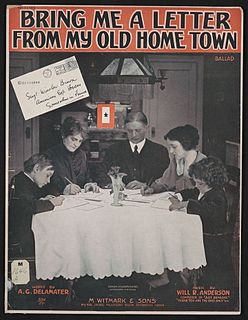
"Bring Me a Letter from My Old Home Town" is a World War I era ballad song released in 1918. A.G. Delamater wrote the lyrics and Will R. Anderson composed the music. It was written for both voice and piano.

There's a Service Flag Flying at Our House is a World War I era song released in 1917. The lyrics were written by Thomas Hoier and Bernie Grossman. Al W. Brown composed the music. The song was published by Joe Morris Music Co. of New York, New York. The Starmer Brothers designed the art featured on the sheet music. On the cover are soldiers marching down a street. Crowds of people cheer them on, and service flags wave above them.
El Penitente is a modern dance work by Martha Graham performed to music by Louis Horst. It premiered on August 11, 1940, at the Bennington College Theater, Bennington, Vermont, with costumes by Edythe Gilfond and a set by Arch Lauterer. Isamu Noguchi later redesigned the set and created a new mask.
Land Be Bright is a modern dance work choreographed by Martha Graham to music by Arthur Kreutz with a set and costumes by Charlotte Trowbridge. The unabashedly patriotic piece premiered on March 14, 1942, at Chicago's Civic Opera House. The original cast included Graham and members of the Martha Graham Dance Company.
Columbiad is a solo modern dance choreographed by Martha Graham to music by Louis Horst. Edythe Gilfond designed the costume; Philip Stapp created the set. The ballet premiered on December 27, 1939, at the St. James Theatre in New York City. Columbiad's debut was part of an event called the Holiday Dance Festival, which included four additional works by Graham and pieces by the American Ballet Caravan, Carmalita Maracci and Dance Group, and Korean modern dancer Sai Shoki.

"That's a Mother's Liberty Loan" is a World War I era song released in 1917. Clarence Gaskill, Harry Tally, and Harry Mayo wrote the lyrics and composed the music. The song was published by M. Witmark & Sons of New York City. On the cover is a vitagraph photo of actors Edward Earle and Mary Maurice facing one another. The song was written for both voice and piano. It was performed by Greek Evans.

"Say, You Haven't Sacrificed at All! (March)", also written as "Say-You Haven't Sacrificed at All!" or "Say-You Have-n't Sacrificed at All!", is a World War I era song released in 1918. Most sources have attributed the role of composer to Will E. Dulmage and lyricist to J. Fred Lawton, as it is credited on the sheet music cover. One source has their roles reversed, and another source claims both composed the music. The song was published by Chas E. Roat Music Co. of Battle Creek, Michigan. On the cover is a soldier with a head wound, pointing. Behind him are British, French, and American flags. It was written for both voice and piano.
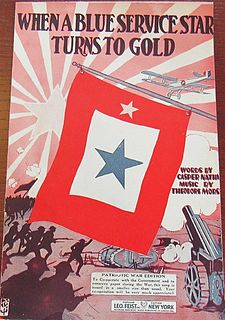
"When a Blue Service Star Turns to Gold" is a World War I era song released in 1918. Caspar Nathan wrote the lyrics. Theodore Morse composed the music. Leo Feist, Inc. of New York, New York published the song. Featured prominently on the sheet music cover is a service star. Beneath it are soldiers charging with artillery, a tank, and a plane. It was written for both voice and piano.

"It's a Long Way to Berlin, But We'll Get There!" is a World War I era song released in 1917. Arthur Fields wrote the lyrics. Leon Flatow composed the music. Leo Feist, Inc. of New York City published the song. Rosenbaum Studios designed the sheet music cover. It features soldiers marching in formation. There is an inset photo of Maurice Burkhardt, Will J. Ward, Ed Morton, Jimmy Flynn, Willie Weston, or Francis Maguire that varies per edition. There is another version of the cover known as the "Popular edition." It features a photo of Henry Bergman.
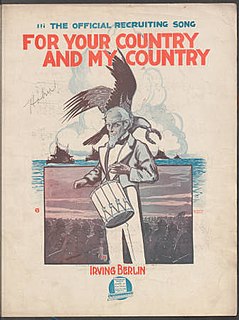
"For Your Country and My Country" is a World War I era song released in 1917. Lyrics and music were written by Irving Berlin. The song was published by Waterson, Berlin & Snyder, Co. of New York, New York. Artist Albert Wilfred Barbelle designed the sheet music cover. It features Uncle Sam playing a snare drum with an eagle on his shoulder. In the background are ships sailing, and below are troops marching. Above the title, it reads, "The Official Recruiting Song." The song was written for voice and piano, along with chords for guitar, ukulele, and banjo.
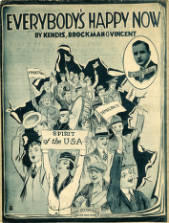
Everybody's Happy Now is a World War I song written by James Kendis, James Brockman, and Nat Vincent in 1918. It was published by Kendis-Brockman Music Co. and written for voice and piano.
My Own America is a World War II song for voice and piano written and composed by Frank C. Huston. The song was self-published in 1940 by F.C. Huston in Indianapolis, IN.
References
- ↑ "Battle of Waterloo". Pritzker Military Museum & Library. Retrieved 7 June 2016.
- ↑ Library of Congress.The Battle of Waterloo / G Anderson [sheet music]. [N.D.] http://memory.loc.gov/diglib/ihas/loc.natlib.ihas.100000295/default.html
- ↑ Conrad, William and Anderson, G, "The Battle of Waterloo" (9999). Parlor Salon Sheet Music Collection. Book 2321. http://digitalcommons.library.umaine.edu/mmb-ps/2321